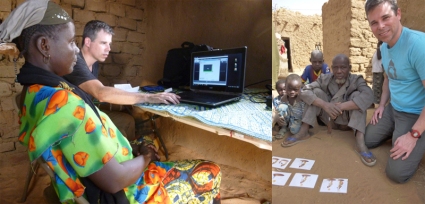Oglesby conducting water literacy research in Africa
Tobii Technology, an eye-tracking company headquartered in Sweden, recently selected graduate thesis research undertaken by Jonathan Oglesby, under the direction of Dr. Leslie North in WKU’s Department of Geography and Geology, as a feature story to showcase on its website.

WKU graduate student Jonathan Oglesby is using eye-tracking technology to investigate and improve water literacy in rural areas along the Niger River in Africa, including the villages of Kakassi (above left) and Garbey Kourou (above right).
Ogelsby’s project centers on the use of eye-tracking technology to investigate and improve water literacy in rural areas of Niger, Africa, through visual learning design. Eye tracking is the ability to measure quantitatively an individual’s points of interest and eye movements when viewing a 2D or 3D visualization. Oglesby conducted eye-tracking research in 23 villages along the Niger River, which included over 500 interviews, nearly 700 focus group participants, and more than 460 eye-tracking trials with individuals.
Most research in the education field concentrates on the advancement of the discipline through the use of outcome assessments and interviews, whereas in this research Oglesby combined emerging mobile Tobii eye-tracking technology, advanced Geographic Information System (GIS)-based spatial statistical analyses, and outcomes assessments to advance knowledge in the discipline in a revolutionary way. This novel approach to education research and unique application of eye-tracking is advancing the discovery and understanding of the ways in which visual communication can be used in informal learning campaigns, not only among rural populations in Africa, where literacy and language barriers exist, but also in the development of educational materials for use in classrooms, textbooks, museums, and science centers in the United States and elsewhere.
Dr. North, thesis advisor for this project, commented: “Minimizing the production and use of obsolete and ineffective educational materials and, instead, promoting the creation of materials that are guided by a data-driven understanding of how an effective visual learning tool should appear, is vital for the promotion of literacy in a multitude of disciplines. We are failing ourselves by not developing educational materials that maximize understanding, particularly among groups that are commonly categorized as societally disadvantaged, such as the population in rural Niger. Understanding these differences through spatial cognition and reasoning is important when dealing with a ubiquitous problem like water scarcity, which manifests itself differently all over the world. It has been an honor to be involved in this project and to work with such an incredible student and person. Jonathan’s passion for his work in Africa is simply contagious in all the right ways.”
Oglesby has created a non-profit organization called Fofo Hari to continue his work in the region even after the research portion is complete. “Fofo Hari grew from my thesis research and quickly became something much bigger than just published work” Oglesby said. “The original goal was to work in Niger, but I never wanted to hold back the reins on Fofo Hari if viable opportunities presented themselves. My first love will always be Niger, and educational materials created from my research will be used in villages there beginning this summer; however, I’m also very excited to have my work being used in other countries. Starting in August, Fofo Hari will begin in Kenya, which will offer a new perspective. It will be very interesting to learn how different cultural groups from Kenya interact and respond to the materials compared to the cultural groups I am working with in Niger.
“My sister and I were at a theme park in Central Florida recently,” he continued. “We were wearing shirts I designed to promote Fofo Hari when a smiling lady named Nyaladzo stopped us. She told us the shirts reminded her of her home country. It turned out to be quite serendipitous as Nyaladzo works as an outreach volunteer in Botswana. When she discovered the meaning behind our shirts, she immediately invited me to come and use my methods in her country. Nyaladzo and I are currently working together to bring Fofo Hari to her homeland. It continues to fascinate me. My background in graphic design and water treatment has given me opportunities even I could not have imagined.”
“This amazing research is another example of the creative ways in which geoscientists are working to understand more clearly the human-environment resource challenges faced by communities globally,” said Dr. David Keeling, Geography and Geology Department Head. “Jonathan’s pioneering work under the guidance of Dr. North is inspirational in the sense that he is demonstrating that there are so many more creative ways to solve problems when you actually understand the physical and cultural contexts within which the problem exists.”
For information about this research or Fofo Hari, visit www.fofohari.org or contact Jonathan Oglesby at jonathan.oglesby@wku.edu or Dr. Leslie North at leslie.north@wku.edu.
Contact: David Keeling, (270) 745-4555






Leave a comment